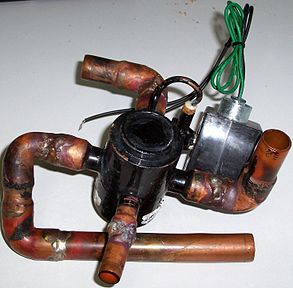- Reversing valve
-
A reversing valve a type of valve and is a component in a heat pump, that changes the direction of refrigerant flow.[1][2][3] By reversing the flow of refrigerant, the heat pump refrigeration cycle is changed from cooling to heating or vice versa. This allows a residence or facility to be heated and cooled by a single piece of equipment, by the same means, and with the same hardware.
Contents
Operation
The reversing valve has two states, relaxed and energized. The energized state is typically achieved by applying 24 volts of alternating current, which is commonly used in HVAC . The heat pump can be designed by the manufacturer to produce cooling or heating with the reversing valve in the relaxed state. When the reversing valve is energized, it will produce the opposite conditioning. In other words, a reversing valve installed in such a way as to produce cooling when relaxed will produce heating when energized. Likewise, a reversing valve installed to produce heating when relaxed will produce cooling when energized.
Control
Depending on the construction and use of the heat pump, the reversing valve may be driven by the heat pump through the use of a control board, or it may be driven directly by a thermostat (typically from the "O" terminal).
Replacement
Reversing valves are built into the heat pump by the manufacturer, and must be replaced by an HVAC technician if they fail.
See also
Reversing Valve Uses
HVAC Information
- HVAC
- Refrigeration cycle
Other HVAC Components
- Thermostat
- Freon compressor
- Heat exchanger
- Thermal expansion valve
- Freeze stat
- Freon
References
Categories:- Heat pumps
- Valves
Wikimedia Foundation. 2010.

